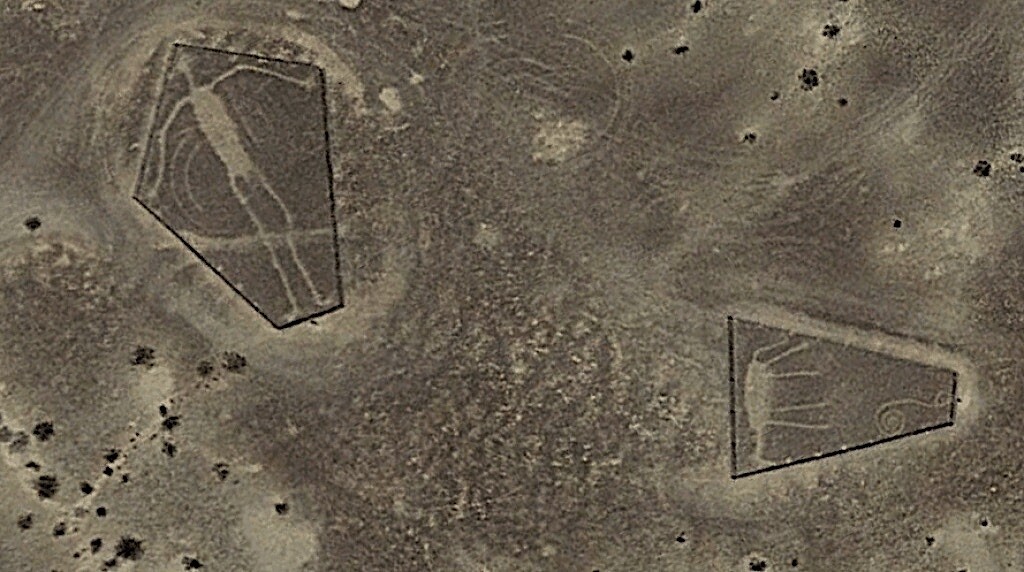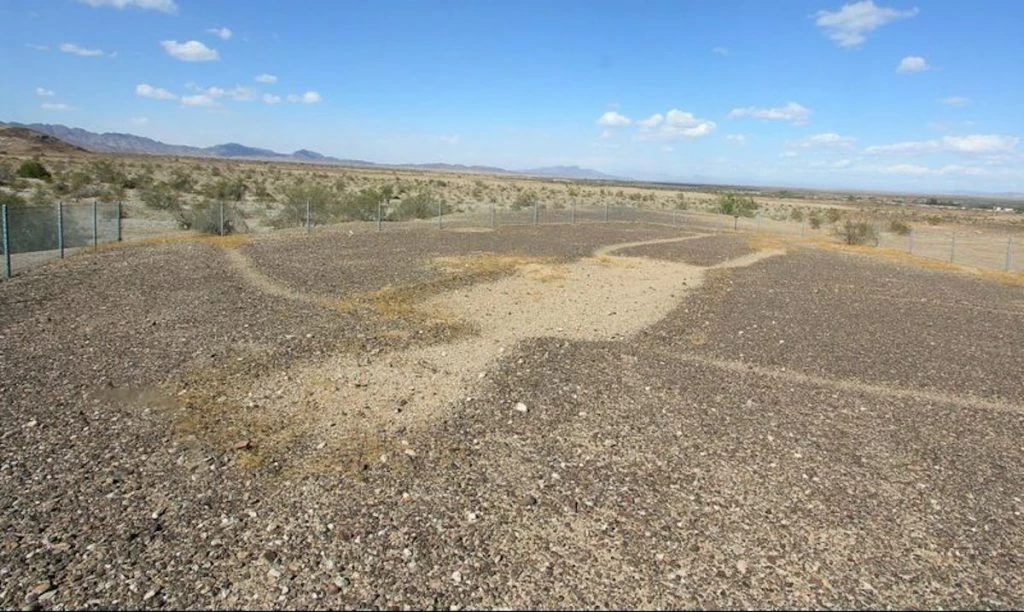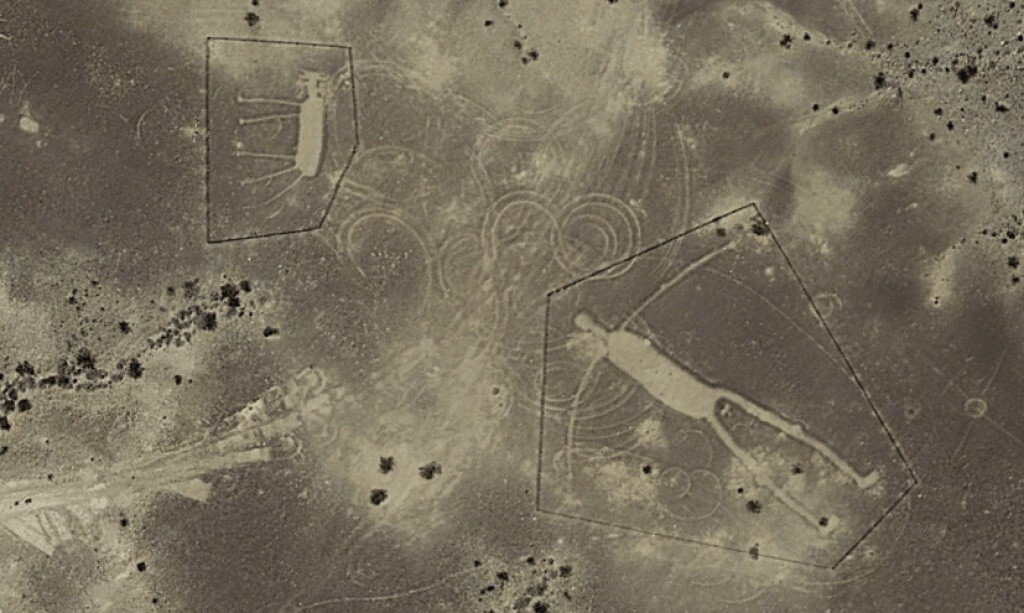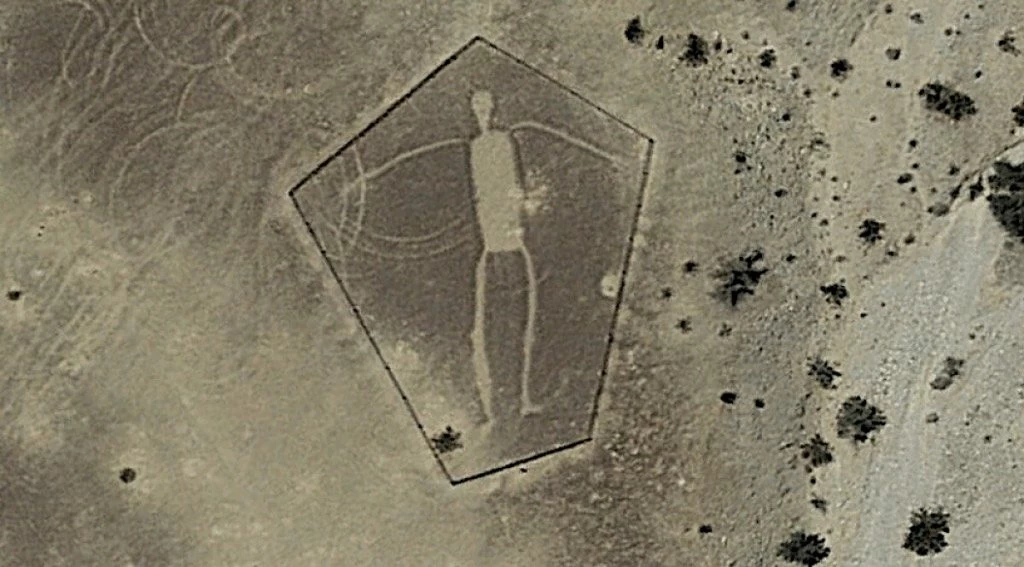Are the Blythe Intaglios works of art or something more?
In the Colorado Desert near the border of California and Arizona, the Blythe Intaglios (or Blythe Geoglyphs) decorate the desert floor. These enormous ground designs remain one of the enduring historic mysteries of the United States. No one knows precisely who created them or when. However, what is certain is that the process of creating these phenomenal pieces of natural art required extensive time and effort. This reveals the importance of the geoglyphs to those who fashioned them.

[blockquote align=”none” author=”recreation.gov”]Their age is inbetween 450-2000 years old. According to the Mohave and Quechans, natives to the lower Colorado River area, the human figures represent Mastamho, the Creator of all life. [/blockquote]
Discovering the Giants of the Desert
Army Air Corps pilot, George Palmer, departed the area of Hoover Dam on the morning of November 12, 1931, for Los Angeles. The flight became anything but routine when Palmer noticed strange figures below him on the barren landscape of the Colorado Desert. What seemed to be depictions of a mountain lion, horses, and a rattlesnake with large rocks for eyes loomed large beyond the cockpit.
Related: Marree Man Geoglyph and its Anonymous Creator
It was the giants, however, that must have held Palmer’s attention. There were anthropomorphic human figures amidst the collection of animals and geometric shapes. Large ones. Additionally, the desert giants appeared to be male. One of them displayed a distinct rendering of its manhood. Another held a spear poised above two fish while the Sun and a serpent watched from above. A third stood with arms and legs outstretched as though he were participating in some ancient ritual or summoning.

There were six figures in total. Palmer interpreted them to represent three humans and three animals. The pilot reported his findings upon landing in Los Angeles, but there was little immediate interest. America was in the throes of the Great Depression. Unless these desert giants could work a special kind of magic that would feed hungry people and help them get back to work, few people were interested. It would be more than 20 years before Palmer’s discovery near Blythe, California, was first investigated.
Geoglyphic Casualties of War
As the Great Depression decimated lives and shattered families from coast to coast, a new threat was emerging in Europe. The rise of Adolf Hitler would soon thrust America into a war that was even more costly than the war for survival at home. Bread lines and relief payments were eclipsed by the more palpable sorrow of family members being sent into battle.
General George S. Patton summoned recruits to the Colorado Desert for training. He apparently had no idea that one of the first casualties of the war effort was the Blythe Intaglios beneath the tires of army vehicles. By the time National Geographic and the Smithsonian sent a team of scientists to explore the intaglios in 1952, some of the desert geoglyphs bore visual marks of tire tracks. Five more years would pass before U.S. park officials would build fences.
Today, the Blythe Intaglios are classified as State Historic Monument No. 101. Fences are still intact, but access to the intaglios is permitted at all hours for those who wish to examine these ancient works of art up close. Some visitors come merely for curiosity, but others come in an effort to puzzle out the riddles that archaeologists have never conclusively solved. Who made these desert giants, and why?
Intaglios in the United States
The word intaglio is Italian. It refers to an engraving process. This describes the design of the Blythe geoglyphs. Native Americans made intaglios in a long and laborious process by scraping away layers of the desert floor. The dark top layer soon gives way to lighter shades as rocks and pebbles are removed. These rocks and pebbles outline the shapes fashioned by the process. The result is something akin to a 3-D effect that anyone can observe from the air as it was by Palmer on his flight.

Intaglios are not uncommon in the U.S. There is, in fact, an entire maze in Needles, California, that someone created via the same process as the Blythe Intaglios. The Topock Maze also remains something of a mystery, with its creators and specific age unknown. The primary examples of intaglios are in the American Southwest, and this helps to narrow speculation of their origins to various Native American tribes that inhabited these areas.
Nazca Lines of Peru and Recent Findings
Researchers have proposed a number of theories regarding the creators of the Blythe Intaglios. Most agree that they are the work of Native Americans who settled along the Colorado River. But attempts to identify the specific tribes responsible have been unsuccessful. One popular theory is that the Patayan people made them during their habitation of the area which lasted from approximately 700-1550 AD.
Mere Art or Religious Iconography?
It is hard to support the idea that these desert geoglyphs are mere works of art. While they are certainly visible from the ground, one can best appreciate them from the air. It is logical to propose that the creators made them to appease eyes that are not mortal.

The Blythe Intaglios are on two mesas. Of the roughly 600 intaglios present in the Southwest United States, those located near Blythe are by far the largest. One of the giant human figures is 171 feet long, more than half the length of a football field. The other human figures are slightly smaller but all are more than 100 feet in length.
Creation Figures
Such enormous dimensions perhaps reflect a certain type of reverence for god figures that was common among Native American peoples. If you ask members of tribal societies which still exist in the area to this day, they will tell you that the human figures are representations of a divine creator. The animal figures exist to convey a creation story. “Their age is inbetween 450-2000 years old. According to the Mohave and Quechans, natives to the lower Colorado River area, the human figures represent Mastamho, the Creator of all life. The animal figures represent Hatakulya, one of two mountain lions/persons who helped in the Creation. In ancient times, sacred ceremonial dances were held in the area to honor the creation” (Recreation.gov). But why fashion them in such a way that they are most visible from the heavens?
There are a few possible explanations. Among the more reasonable is that the Blythe Intaglios serve as a type of offering or tribute to the Native American Creator or God. In this context, the geoglyphs would serve to identify the inhabitants of the land as obedient and faithful servants. Surely, a benevolent god would look down from the heavens with favor at such an elaborate display. In contrast, more extreme theories suggest the intaglios served as a beacon or landmark to an ancient alien race. This would have aided their visit to the mesa in ancient times.
Intaglios as Cultural Identity
There is one point upon which all archaeologists and scientists seem to agree. The greatest value of the Blythe Intaglios may be their ability to preserve the cultural identity of the Native American peoples. It is somewhat ironic that the conquest of America’s original inhabitants occurred in a manner not unlike the process used to create these remarkable geoglyphs. Little by little, the Native American way of life has been scraped away, leaving only a lighter shade of a once colorful and vibrant society.
References:
Bureau of Land Management
Wikipedia